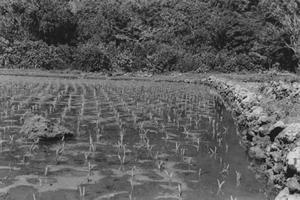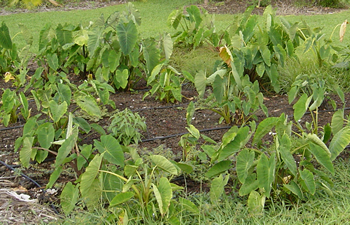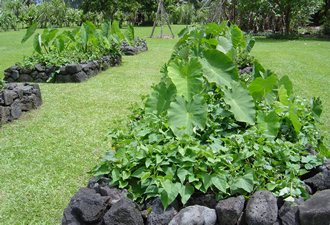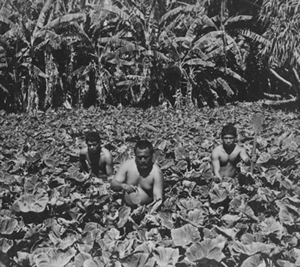Lo‘i/wetland Wetland cultivation took place on stream banks, in marshy areas of freshwater springs, but most commonly in lo‘i or irrigated pondfields. Lo‘i came to occupy much of the flat, arable land in water rich valleys. Building a lo‘i was labor intensive, and required constant maintenance and care. The base of the huli (leaf stalk consisting of a half-inch-thick slice of the top of the corm attached to 6-10 inches of the leaf-stem) was placed straight into the muddy pond or placed in man-made mounds and left for six to twelve months. As the crop grew, the water level was gradually raised to keep the base of the plant submerged. However, the water was kept flowing at all times, otherwise its oxygen content became low and rot organisms attacked the kalo. Farmers were careful not to step on or around the developing corms, yet managed to keep each pond weed-free. Kalo was planted at intervals to assure a daily or weekly harvest. Wetland kalo was primarily made into poi.




Upland/dryland Relying on rainfall for irrigation, dryland cultivation favors very moist environments, but can also occur in drier areas with constant mulching. Forest land was frequently cleared for dryland cultivation. One technique practiced in dryland farming was to use fern fronds as mulch during times of high light exposure and to remove the fronds during times of adequate rainfall. Banana stumps, fermented breadfruit and burnt coconut fiber ash were also used as mulching material. Dryland taro was usually grown by placing the huli into a mound of soil, which gave the corm adequate room for expansion. An ‘ō‘ō (digging stick)was used to prepare the hole for the huli. Mulch was placed around the base of the planting and natural rainfall provided watering. Dryland taro takes longer to mature than wetland varieties, about 8-12 months. Some dryland varieties could remain in the soil for three to twelve months beyond maturity. Most Lauloa varieties could stay in the ground indefinitely. Dryland taro was usually eaten in chunks after being baked or steamed.



